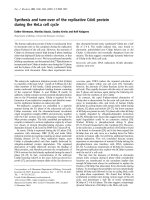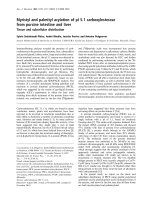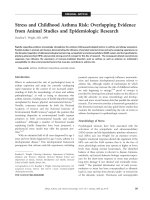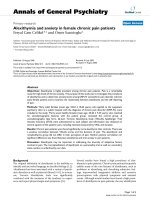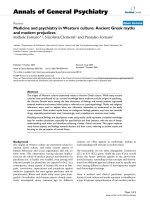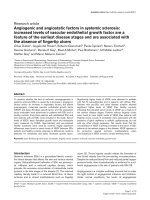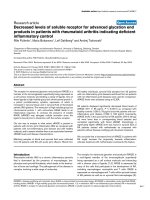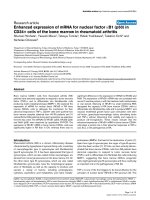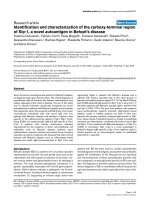Báo cáo y học: "Incidence and Risk Factors for Malaria, Pneumonia and Diarrhea in Children Under 5 in UNHCR Refugee Camps: A Retrospective Study" potx
Bạn đang xem bản rút gọn của tài liệu. Xem và tải ngay bản đầy đủ của tài liệu tại đây (8.05 MB, 31 trang )
This Provisional PDF corresponds to the article as it appeared upon acceptance. Fully formatted
PDF and full text (HTML) versions will be made available soon.
Incidence and Risk Factors for Malaria, Pneumonia and Diarrhea in Children
Under 5 in UNHCR Refugee Camps: A Retrospective Study
Conflict and Health 2011, 5:24 doi:10.1186/1752-1505-5-24
Christine L Hershey ()
Shannon Doocy ()
Jamie Anderson ()
Christopher Haskew ()
Paul Spiegel ()
William J Moss ()
ISSN 1752-1505
Article type Research
Submission date 27 May 2011
Acceptance date 26 October 2011
Publication date 26 October 2011
Article URL />This peer-reviewed article was published immediately upon acceptance. It can be downloaded,
printed and distributed freely for any purposes (see copyright notice below).
Articles in Conflict and Health are listed in PubMed and archived at PubMed Central.
For information about publishing your research in Conflict and Health or any BioMed Central journal,
go to
/>For information about other BioMed Central publications go to
/>Conflict and Health
© 2011 Hershey et al. ; licensee BioMed Central Ltd.
This is an open access article distributed under the terms of the Creative Commons Attribution License ( />which permits unrestricted use, distribution, and reproduction in any medium, provided the original work is properly cited.
Incidence and Risk Factors for Malaria, Pneumonia and Diarrhea in Children Under 5 in
UNHCR Refugee Camps: A Retrospective Study
Christine L. Hershey,
1
Shannon Doocy,
1
Jamie Anderson,
1
Christopher Haskew,
2
Paul Spiegel,
2
and William J. Moss
1*
1
Bloomberg School of Public Health, Johns Hopkins University, Baltimore, Maryland, USA
2
United Nations High Commissioner for Refugees, Geneva, Switzerland
Email addresses:
CLH:
SD:
JA:
CH:
PS:
WJM:
* Corresponding author
2
Abstract
Background: United Nations High Commissioner for Refugees (UNHCR) refugee camps are
located predominantly in rural areas of Africa and Asia in protracted or post-emergency
contexts. Recognizing the importance of malaria, pneumonia and diarrheal diseases as major
causes of child morbidity and mortality in refugee camps, we analyzed data from the UNHCR
Health Information System (HIS) to estimate incidence and risk factors for these diseases in
refugee children younger than five years of age.
Methods: Data from 90 UNHCR camps in 16 countries, including morbidity, mortality, health
services and refugee health status, were obtained from the UNHCR HIS for the period January
2006 to February 2010. Monthly camp-level data were aggregated to yearly estimates for
analysis and stratified by location in Africa (including Yemen) or Asia. Poisson regression
models with random effects were constructed to identify factors associated with malaria,
pneumonia and diarrheal diseases. Spatial patterns in the incidence of malaria, pneumonia and
diarrheal diseases were mapped to identify regional heterogeneities.
Results: Malaria and pneumonia were the two most common causes of mortality, with
confirmed malaria and pneumonia each accounting for 20% of child deaths. Suspected and
confirmed malaria accounted for 23% of child morbidity and pneumonia accounted for 17% of
child morbidity. Diarrheal diseases were the cause of 7% of deaths and 10% of morbidity in
children under five. Mean under-five incidence rates across all refugee camps by region were:
malaria [Africa 84.7 cases/1000 U5 population/month (95% CI 67.5-102.0), Asia 2.2/1000/month
(95% CI 1.4-3.0)]; pneumonia [Africa 59.2/1000/month (95% CI 49.8-68.7), Asia
254.5/1000/month (95% CI 207.1-301.8)]; and diarrheal disease [Africa 35.5/1000/month (95%
CI 28.7-42.4), Asia 69.2/1000/month (95% CI 61.0-77.5)]. Measles was infrequent and
accounted for a small proportion of child morbidity (503 cases, <1%) and mortality (6 deaths,
<1%).
3
Conclusions: As in stable settings, pneumonia and diarrhea are important causes of mortality
among refugee children. Malaria remains a significant cause of child mortality in refugee camps
in Africa and will need to be addressed as part of regional malaria control and elimination
efforts. Little is known of neonatal morbidity and mortality in refugee settings, and neonatal
deaths are likely to be under-reported. Global measles control efforts have reduced the
incidence of measles among refugee children.
4
Background
United Nations High Commissioner for Refugees (UNHCR) refugee camps are located
predominantly in rural areas of Africa and Asia in protracted or post-emergency contexts. In
these settings, refugee populations benefit from relatively stable environments and, in contrast
to acute phase emergencies, mortality rates rarely exceed emergency thresholds and often are
lower among refugees than surrounding host populations [1]. Factors contributing to lower
mortality in refugee camps include better access to primary health care (including vaccination
and nutrition programs), adequate water and sanitation, and implementation of public health
measures such as disease surveillance [2-4]. The burden of disease in refugee camps is similar
to that in developing countries and includes malaria, pneumonia, diarrheal disease, neonatal
mortality and malnutrition [5]. Communicable diseases account for the majority of morbidity in
emergency-affected populations and are often exacerbated by high rates of malnutrition [5,6].
Crowding, inadequate shelter, and poor access to water and sanitation further contribute to an
increased risk of communicable diseases in camp settings. Specifically, temporary shelters and
diminished vector control efforts contribute to increased malaria transmission. Pneumonia can
result from overcrowding, indoor cooking fires and poor shelter construction. Improper
sanitation, contamination of drinking water, and insufficient quantities of potable water increase
the risk of diarrhea.
The characteristics of health facilities, nutrition programs, and access to water and
sanitation are routinely monitored in UNHCR refugee camps. Much of this information is
captured by the UNHCR camp registration system, ProGres, and the Health Information System
(HIS). The UNHCR HIS collects standardized camp-level data and is a resource for monitoring
health and disease within refugee camps in different countries in collaboration with
implementing partners [7]. The HIS, established in 2006, is currently operational in refugee
camps in 16 countries: Bangladesh, Burundi, Cameroon, Chad, Democratic Republic of Congo,
5
Djibouti, Ethiopia, Kenya, Namibia, Nepal, Rwanda, Sudan, Tanzania, Thailand, Uganda and
Yemen. The HIS collects data on mortality, in-patient and out-patient visits, immunization
coverage, reproductive health and nutrition. Data are collected weekly and compiled into
monthly reports that are entered into the HIS database. Additionally, UNHCR produces yearly
factsheets for each camp, providing information on key health indicators and services that fall
below standards [7,8]. Recognizing the importance of malaria, pneumonia and diarrheal
diseases as major causes of child morbidity and mortality in refugee camps, we analyzed data
from the UNHCR HIS to estimate the incidence and risk factors for these diseases in refugee
children younger than five years of age.
Methods
Data from 90 UNHCR refugee camps in 16 countries, including morbidity, mortality,
health services and refugee health status, were obtained from the UNHCR HIS (v1.6.12.1) for
the period January 2006 to February 2010 [9]. Monthly camp-level data were exported from HIS
into Stata 11 (StataCorp LP, College Station, Texas, USA) and monthly averages for each camp
in a given year were generated for analysis. Morbidity estimates were based on outpatient visits.
Suspected and confirmed cases of malaria were combined for the morbidity analyses, and
cases of watery and bloody diarrhea were combined for both morbidity and mortality analyses.
The following HIS case definitions were used: 1) suspected uncomplicated malaria was
diagnosed in persons with fever or history of fever within the past 48 hours (with or without other
symptoms such as nausea, vomiting and diarrhea, headache, back pain, chills or myalgia) in
whom other obvious causes of fever were excluded; 2) suspected severe malaria was
diagnosed in persons with symptoms as for uncomplicated malaria, as well as drowsiness with
extreme weakness and associated signs and symptoms related to organ failure such as
disorientation, loss of consciousness, convulsions, severe anemia, jaundice, hemoglobinuria,
6
spontaneous bleeding, pulmonary edema and shock; 3) confirmed malaria was diagnosed in
persons with uncomplicated or severe malaria with laboratory confirmation by malaria blood film
or other diagnostic test for malaria parasites; 4) upper respiratory tract infection was diagnosed
in persons with runny nose, cough and low grade fever; 5) pneumonia was diagnosed in
children 2 months to 5 years of age with cough or difficulty breathing and breathing faster than
50 breaths/minute (2-12 months of age) or breathing faster than 40 breaths/minute (1-5 years of
age); 6) watery diarrhea was diagnosed in persons with diarrhea (passage of 3 or more watery
or loose stools in the past 24 hours) with or without dehydration; 7) bloody diarrhea was
diagnosed in persons with diarrhea (passage of 3 or more watery or loose stools in the past 24
hours) and visible blood in the stool; 8) acute moderate malnutrition was diagnosed in children
with a weight for height index of ≤ -2 and > -3 z-scores, or ≤ 80% and > 70% of median, or any
child with a mid-upper arm circumference (MUAC) of >115 mm and ≤125 mm; 9) acute severe
malnutrition was diagnosed in children with a weight for height index of ≤ -3 z-scores or any
child with a MUAC of ≤115 mm or any child with kwashiorkor [7].
Camp characteristics and intervention levels were examined for their association with
disease incidence, and included camp size (total population and under-5 population), indicators
of adequate water and sanitation (water quality, access and proximity; latrine access and
coverage; soap access), nutrition standards (global acute malnutrition and ration adequacy) and
health service utilization (new visits per 10 persons/month and growth monitoring). For malaria,
camp-level indictors of the prevention of malaria in pregnant women were analyzed (insecticide-
treated nets [ITN] and intermittent preventive treatment for malaria in pregnancy [IPTp]
coverage).
These camp characteristics were examined for outliers, zero values or inconsistencies.
Outliers and inconsistent values were assumed to be reporting errors and were replaced with
the average value of the two months surrounding the excluded value. Values for growth
monitoring utilization, ITN ownership by pregnant women and IPTp above 100% were reset to
7
100%. Extreme outlier values for malaria, pneumonia and diarrhea morbidity also were replaced
with the average value from the preceding and succeeding months. Camp population was
modeled as a categorical variable based on terciles (0-9,999; 10,000-19,999; ≥20,000 persons).
Camps were stratified into two geographic regions, Asia and Africa (including Yemen) for some
analyses. Annual camp-level water and sanitation variables, including measures of access to
water and latrines, and nutrition variables, including receipt of adequate food and the
prevalence of undernutrition, were obtained from UNHCR annual factsheets and were
converted to dichotomous variables based on performance above or below specified UNHCR
standards [10].
Data analysis was conducted in Stata 11 and included summary measures of disease
incidence and multivariable Poisson regression analyses to identify factors associated with
disease. Camp characteristics and health status were compared between regions using t-tests
for continuous variables and chi-square tests for categorical variables, using a cutoff of <0.05 as
statistically significant. Bivariate and multivariable Poisson regression models with random
effects were constructed for malaria, pneumonia and diarrheal disease as dependent variables.
UNHCR camp was used as the clustering variable and the offset was the average monthly
camp population of children under five in each year. Standard errors in the multivariable models
were calculated using bootstrapping with 1000 repetitions to correct for correlations between
repeated measures in each camp.
The bivariate and multivariate analyses were restricted to those camps in 2007-2009 for
which at least 8 months of data were available in a given year to account for potential
seasonality in disease outcomes. Not all camps were included in the HIS in 2006 and complete
HIS datasets were not available for 2010 at the time of analysis. These criteria excluded three
countries from bivariate and multivariate analyses (Democratic Republic of Congo, Djibouti and
Namibia) and restricted the analysis to 80 of the 90 camps. The Poisson models for malaria
were further restricted to camps with an average monthly malaria incidence rate of 4 or more
8
cases/1000 under five population/month in a given year to exclude camps in regions where
malaria transmission was minimal or absent. All camps were included in the proportional
morbidity and mortality assessments and GIS mapping.
ArcGIS 9.2 (Redlands, CA) was used to map the incidence of malaria, pneumonia and
diarrheal disease and assess regional heterogeneities. Camp incidence rates were displayed
over projections of malaria parasite prevalence from the Malaria Atlas Project (MAP) [11] or the
country under-five mortality rates from the 2007 UNICEF State of the World’s Children’s Reports
[12].
Camp-level period incidence rates were calculated using all reported cases in children
younger than five years from 2006 to 2010, and are reported as cases per 1000 children
younger than five years per month. The mapped incidence rates were divided into quintiles as
indicated by the size and color of the circles.
Results
Camp characteristics. Because UNHCR had more refugee camps in Africa than Asia, 117
camp-years were analyzed for Africa and 36 for Asia. Camp characteristics in Africa and Asia
were significantly different (Table 1), with larger camps more common in Africa. Health facility
visits (adjusted for population size) (0.29 visits/person/months vs. 0.15, p<0.001) and growth
monitoring (68.4% vs. 37.3%, p<0.001) were more common in camps in Asia than Africa (Table
1). Camps in Asia also met standards for water and sanitation services more frequently than
those in Africa (e.g. quantity of water, person per water tap, distance to water source and
percentage of families with a latrine). As an overall indicator of child health, malnutrition was
more prevalent in Africa (48.6% of camps with ≥10% global malnutrition) than Asia (25.0%,
p=0.014) (Table 1).
9
Causes of Child Morbidity and Mortality. The leading causes of morbidity and mortality in
children younger than five years of age in the UNHCR refugee camps were malaria, pneumonia
and diarrheal disease (Figure 1). Malaria and pneumonia were the two most common causes of
mortality overall, with confirmed malaria and pneumonia each accounting for 20% of child
deaths. Suspected and confirmed malaria accounted for 23% of child morbidity, whereas
pneumonia accounted for 17% of child morbidity. Diarrheal diseases were the cause of 7% of
deaths and 10% of morbidity in children under five.
Mean under-five incidence rates across all refugee camps by region were: malaria
[Africa 84.7 cases/1000 U5 population/month (95% CI 67.5-102.0), Asia 2.2/1000/month (95%
CI 1.4-3.0)]; pneumonia [Africa 59.2/1000/month (95% CI 49.8-68.7), Asia 254.5/1000/month
(95% CI 207.1-301.8)]; and diarrheal disease [Africa 35.5/1000/month (95% CI 28.7-42.4), Asia
69.2/1000/month (95% CI 61.0-77.5)].
Causes of mortality varied by region. Malaria was the leading cause of death in camps in
Africa but accounted for no deaths in Asia. Pneumonia was a major cause of death in both
regions but had a substantially higher incidence rate in Asia than Africa. Diarrheal diseases
were proportionally a more frequent cause of death in Africa than in Asia (Figure 2 A and B).
Neonatal deaths (within the first 28 days of life) were more prevalent in Asia (28% of under five
deaths) and acute malnutrition as a cause of death was more common in Africa (11%) (Figure 2
A and B).
Regional variations in morbidity also were identified (Figure 2 C and D). In Africa,
malaria was the leading cause of clinical visits, accounting for 28% of health facility
consultations among children under five. Diarrheal diseases were a leading cause of under five
morbidity in both regions, and pneumonia was more prevalent in Asia than Africa (Figure 2 C
and D). Although not severe, upper respiratory tract infections accounted for a significant
proportion of morbidity (29%) (Figure 1). Skin diseases and intestinal worms were other causes
10
of morbidity in children under five. Surprisingly, measles accounted for only a small proportion of
child morbidity (503 cases, <1%) and mortality (6 deaths, <1%).
Risk factors for child morbidity. Region and recent health facility visits were significantly
associated with malaria incidence (Table 2): the incidence of malaria in Africa was 40-100 times
greater than in Asia (Table 1, p<0.001). Neither ITN ownership during pregnancy (IRR=0.74,
95% CI 0.44-1.24) nor IPTp with two doses of sulfadoxine-pyrimethamine (IRR=1.12, 95% CI
0.25-4.99) was significantly associated with the incidence of malaria. Health service utilization
(number of new visits/10 persons) was associated with increased risk of malaria (IRR=2.57,
95% CI 1.48-4.48), which may reflect increased care seeking for children with malaria (Table 2).
The incidence of pneumonia was associated with proximity to a water source, camp
population size and new visits to a health facility (Table 3). Compared to Africa, camps in Asia
had a higher risk of pneumonia (IRR=4.52, 95% CI 3.18-6.41); however, this was not significant
after adjusting for other camp characteristics. Large camps with populations ≥20,000 were
associated with a significantly increased risk for pneumonia compared to small (<10,000) camps
(IRR=2.07, 95% CI 1.03-4.15). As for malaria, a higher number of new patient visits to a health
facility was associated with an increased risk for pneumonia (IRR=1.73, 95% CI 1.26-2.37),
perhaps reflecting increased care seeking.
Camp size and new patient visits were also significantly associated with diarrheal
disease in multivariable analyses (Table 3). Camps in Asia were more likely to have cases of
diarrheal disease than those in Africa (IRR=1.93, 95% CI 1.52-2.45); however, region alone was
not significant after accounting for other camp characteristics. Camps with large (≥20,000
refuges) and medium (10,000-19,999 refugees) size populations were associated with
increased patient visits for diarrhea (IRR=2.16, 95% CI 1.04-4.49 and IRR=1.80, 95% CI 1.07-
3.03, respectively) compared to small (<10,000 persons) camps. Again, increased new patient
visits was associated with an increase in patient visits for diarrhea (IRR=1.90, 95% CI 1.38-
11
2.62). In the unadjusted and adjusted models, none of the indicators of water and sanitation
were significantly associated with diarrheal disease (Table 3).
Mapping disease incidence rates. To assess spatial heterogeneities across UNHCR camps,
disease incidence was mapped. Average malaria incidence (new cases per 1000 under-five
population per month) for the period January 2006 to February 2010 in UNHCR camps was
overlaid on the parasitemia rate of Plasmodium falciparum in children between 2 to 10 years-
old obtained from the Malaria Atlas Project (Figure 3). With the exception of several camps in
Sudan, camps located in areas of Asia and northeastern Africa with low PfPR
2-10
also had low
rates of malaria in UNHCR camps. For example, in Chad the incidence rates of malaria were
consistent with the underlying parasite prevalence in the area. The average incidence rates of
pneumonia and diarrheal disease (new cases per 1000 under-five population per month) in
UNHCR camps for the period January 2006 to February 2010 were overlaid on host-country,
under-five mortality rates obtained from the UNICEF State of the World’s Children Report in
2007 (Figures 4 and 5). These maps highlight the heterogeneity at both the country and regional
level in pneumonia and diarrheal disease incidence rates at UNHCR camps and their
relationship to under-five mortality rates at the national level.
Discussion
Analysis of UNHCR HIS data from 90 refugee camps in 16 countries indicated that the
primary causes of mortality among camp-based refugee children younger than five years of age
were malaria (20%), pneumonia (20%), diarrheal disease (7%), neonatal deaths (11%) and
acute malnutrition (10%). The finding that the causes of under-five mortality in refugee and
emergency settings are comparable to countries with high levels of child mortality has been
observed previously [1,13,14]. However, the proportions of deaths due to diarrhea and neonatal
12
causes at UNHCR camps were lower than expected and that due to malaria higher than global
estimates (the latter reflecting, in part, the preponderance of UNHCR camps in Africa). Cause-
specific mortality among children under-five worldwide include pneumonia (18%), diarrhea
(15%), malaria (8%), and neonatal causes (41%) [15], with undernutrition contributing to half of
under-five deaths.
There are several potential explanations for these differences. Little is known of neonatal
morbidity, mortality and care practices in refugee settings. Neonatal deaths are likely to be
underreported at these camps, contributing to the relatively low proportion of deaths due to
neonatal causes. Efforts to improve access to maternal and newborn care services also could
have contributed. The relatively low proportion of deaths due to diarrhea may reflect improved
access to water and sanitation in these refugee settings, although no associations were
observed. In contrast, despite reductions in the burden of malaria in parts of sub-Saharan Africa
[16], malaria remains an important cause of child mortality among refugees, in part reflecting the
location of refugee camps. Data on the proportion of children younger than five years of age
sleeping under an ITN or the use of artemisinin-combination therapy to treat malaria were not
available.
Historically, measles was a major cause of child mortality in emergencies and refugee
camps [6,14,17] but reductions in global measles incidence and mortality likely decreased the
risk of measles in refugee populations [18,19]. In addition, measles vaccine coverage is likely
higher in these post-emergency camps. In contrast to many acute emergencies [20], violence
and trauma were not major causes of child morbidity or mortality.
Nutritional status and indicators of water and sanitation were hypothesized to be
associated with disease incidence, particularly for diarrheal diseases, and indicators of access
to water, sanitation and food, as well as levels of acute malnutrition, were assessed as
predictors of disease incidence using UNHCR performance standards. However, no measures
of water and sanitation were significantly associated with disease incidence (with the exception
13
of proximity to a water source and the risk of pneumonia, which is likely not a causal
association). Water quantity and accessibility were assessed, but water quality was not
addressed. A previous study of refugee camps in sub-Saharan Africa highlighted the burden of
diarrhea morbidity and mortality attributable to incomplete water and sanitation and the fact that
mortality due to diarrhea was lower in camps than in the host country [21]. As shown in the
maps, striking differences in disease incidence were observed at some UNHCR camps located
in close proximity, and contrasted with national background rates of disease, suggesting that
multiple local factors contribute to disease incidence within a given camp.
Few large-scale studies of refugee children exist for comparison. One prior study of 51
post-emergency phase refugee camps in seven countries assessed predictors of crude and
under-five mortality [3]. Contrary to the association of larger camp size with pneumonia and
diarrhea in these UNHCR camps, larger camp size was associated with a lower risk of adverse
health outcomes in the earlier study. Risk factors for higher crude mortality included newly
opened camps, proximity to conflict regions and increased travel time to referral hospitals.
Increased under-five mortality was associated with poorer access to potable water and elevated
rates of diarrheal disease. Access to sanitation (number of people per functioning latrine) was
associated with reductions in crude mortality but no statistically significant association was
observed between access to latrines and under-five mortality, similar to the findings in these
UHNCR camps.
The HIS was designed to provide basic information on refugee health status and
services provided by health facilities in camps. Missing data, particularly for seasonal infectious
diseases, may have biased morbidity and mortality estimates. Because the covariates were
camp-level characteristics, associations between risk factors for disease and disease incidence
may not have been observed. Individual-level data may be necessary to detect these
associations.
14
Conclusions
As in stable settings, pneumonia and diarrhea are important causes of mortality among
refugee children. Malaria remains a significant cause of child mortality in refugee camps in
Africa and will need to be addressed as part of regional malaria control and elimination. Little is
known of neonatal morbidity and mortality in refugee settings, and neonatal deaths are likely to
be under-reported. Global measles control efforts have reduced the incidence of measles
among refugee children.
15
List of Abbreviations
HIS = health information system; IRR = incidence rate ratio; ITN = insecticide-treated net;
IPTp = intermittent preventive treatment in pregnancy; MAP = Malaria Atlas Project; MUAC =
mid-upper arm circumference; UNHCR = United Nations High Commissioner for Refugees
Competing Interests
The authors declare that they have no competing interests.
Authors Contributions
CLH conducted the analyses and drafted the manuscript. SD conceived of the study and
participated in the design, coordination and drafting of the manuscript. JA assisted with the
spatial mapping. CH conceived of the study and participated in the design, coordination and
drafting of the manuscript. PS conceived of the study and participated in the design,
coordination and drafting of the manuscript. WJM participated in the design, coordination and
drafting of the manuscript. All authors have read and approved the final manuscript.
Acknowledgements
The authors thank Hannah Tappis for helpful discussions about the UNHCR HIS database. We
would also like to thank Dr. Elizabeth Colantuoni, Dr. John McGready, Mark Van Natta,
Katherine Lin, Jeff Goldsmith and Matt McCall for statistical advice.
16
References
1. Salama P, Spiegel P, Talley L, Waldman R: Lessons learned from complex
emergencies over past decade. Lancet 2004, 364:1801-1813.
2. Spiegel PB, Checchi F, Colombo S, Paik E: Health-care needs of people affected by
conflict: future trends and changing frameworks. Lancet 2010, 375:341-345.
3. Spiegel P, Sheik M, Gotway-Crawford C, Salama P: Health programmes and policies
associated with decreased mortality in displaced people in postemergency phase
camps: a retrospective study. Lancet 2002, 360:1927-1934.
4. Hynes M, Sheik M, Wilson HG, Spiegel P: Reproductive health indicators and
outcomes among refugee and internally displaced persons in postemergency phase
camps. JAMA 2002, 288:595-603.
5. Black RE, Morris SS, Bryce J: Where and why are 10 million children dying every
year? Lancet 2003, 361:2226-2234.
6. Connolly MA, Gayer M, Ryan MJ, Salama P, Spiegel P, Heymann DL: Communicable
diseases in complex emergencies: impact and challenges. Lancet 2004, 364:1974-
1983.
7. UNHCR: Health Information System Training Manual to Support Implementation in
Refugee Operations. Geneva: UNHCR; 2007.
8. UNHCR. 2008 Programme Overview Factsheets: Refugee Public Health. 2009.
Geneva, UNHCR.
9. UNHCR. Health Information System Database. 2011.
10. UNHCR. Annual Program Factsheets. 2011.
11. Malaria Atlas Project (MAP).
12. UNICEF. The 2010 State of the World's Children Report. 2010.
13. Toole MJ, Waldman RJ: The public health aspects of complex emergencies and
refugee situations. Annu Rev Public Health 1997, 18:283-312.
14. Moss WJ, Ramakrishnan M, Storms D, Henderson Siegle A, Weiss WM, Lejnev I, Muhe L:
Child health in complex emergencies. Bull World Health Organ 2006, 84:58-64.
15. Black RE, Cousens S, Johnson HL, Lawn JE, Rudan I, Bassani DG, Jha P, Campbell H,
Walker CF, Cibulskis R et al.: Global, regional, and national causes of child mortality
in 2008: a systematic analysis. Lancet 2010, 375:1969-1987.
16. O'Meara WP, Mangeni JN, Steketee R, Greenwood B: Changes in the burden of
malaria in sub-Saharan Africa. Lancet Infect Dis 2010, 10:545-555.
17. Toole MJ, Steketee RW, Waldman RJ, Nieburg P: Measles prevention and control in
emergency settings. Bull World Health Organ 1989, 67:381-388.
17
18. Wolfson LJ, Strebel PM, Gacic-Dobo M, Hoekstra EJ, McFarland JW, Hersh BS: Has the
2005 measles mortality reduction goal been achieved? A natural history modelling
study. Lancet 2007, 369:191-200.
19. World Health Organization: Global reductions in measles mortality 2000-2008 and the
risk of measles resurgence. Weekly Epidemiol Rec 2009, 84:509-516.
20. Degomme O, Guha-Sapir D: Patterns of mortality rates in Darfur conflict. Lancet 2010,
375:294-300.
21. Cronin AA, Shrestha D, Spiegel P, Gore F, Hering H: Quantifying the burden of disease
associated with inadequate provision of water and sanitation in selected sub-
Saharan refugee camps. J Water Health 2009, 7:557-568.
18
Figure Legends
Figure 1. Cause-specific morbidity and mortality in children younger than five years of age for
refugee camps in the UNHCR HIS database, January 2006 to February 2010
A. Mortality for all recorded causes. Cases of watery and bloody diarrhea were combined. B.
Out-patient visits for major causes of morbidity within refugee camps. Suspected and confirmed
cases of malaria were combined, as were cases of watery and bloody diarrhea. Only causes
accounting for 5% or more of mortality or morbidity are shown, with the remaining causes listed
as “Other”.
Figure 2. Major causes of mortality and morbidity in children younger than five years of age by
region
Mortality is shown for all listed causes in (A) African and (B) Asian UNHCR refugee camps.
Cases of watery and bloody diarrhea were combined. (C and D) Out-patient visits for the major
causes of morbidity in UNHCR refugee camps by region. Suspected and confirmed malaria
cases, and watery and bloody diarrhea, were combined. Only those causes accounting for 5%
or more of mortality or morbidity are shown, with the remaining causes listed as “Other”.
Figure 3. Incidence of malaria in UNHCR refugee camps in Africa and Asia
The incidence rate for malaria (cases per 1000 under five population per month) during the
period January 2006 to February 2010 in refugees under five years old in the UNHCR camps is
shown by circles. The background represents the parasite prevalence in children 2 to 10 years
19
of age from the Malaria Atlas Project. The size and color of the circles reflect the incidence rate
quintiles for the refugee camps.
Figure 4. Incidence of pneumonia in UNHCR refugee camps in Africa and Asia
The incidence rate for pneumonia (cases per 1000 under five population per month) during the
period January 2006 to February 2010 in refugees under five years old in the UNHCR camps is
shown over the national under five mortality rate for each country obtained from the 2007
UNICEF State of the World’s Children Report. The size and color of the camps reflects the
incidence rates divided into quintiles. The country mortality rate is shown as shades of green.
Figure 5. Incidence of diarrhea in UNHCR refugee camps in Africa and Asia
The incidence rate for diarrheal diseases (cases per 1000 under five population per month)
during the period January 2006 to February 2010 in refugees under five years old in the
UNHCR camps is shown over the national under five mortality rate for each country obtained
from the 2007 UNICEF State of the World’s Children Report. The size and color of the camps
reflects the incidence rates divided into quintiles. The country mortality rate is shown as shades
of green.
20
Table 1. Characteristics of UNHCR refugee camps by region
a
Africa
(n=117)
b
Asia
(n=36)
p
-
value
c
Camp Population
d
Total population (%)
<10,000
10,000-<20,000
≥20,000
Under five (U5) population [mean (95% CI)]
26.5
37.6
35.9
3812 (3180-4445)
25.0
63.9
11.1
1761 (1405-2117)
0.007
<0.001
Incidence Rates (U5 cases/1000
population/month)
d
Malaria
Pneumonia
Diarrhea
84.7 (67.5-102.0)
59.2 (49.8-68.7)
35.5 (28.7-42.4)
2.2 (1.4-3.0)
254.5 (207.1-301.8)
69.2 (61.0-77.5)
<0.001
<0.001
<0.001
Health Facility Utilization
d
New visits/person/month
Growth monitoring utilization (%)
0.15 (0.13-0.16)
37.3 (31.4-43.1)
0.29 (0.27-0.32)
64.8 (55.2-74.3)
<0.001
<0.001
Malaria Prevention during Pregnancy
d
Insecticide treated net coverage (ITN) (%)
Intermittent preventative treatment (IPTp) (%)
50.4 (43.4-57.5)
68.7 (62.5-74.9)
10.2 (1.4-18.9)
0.78 (0.03-1.5)
<0.001
<0.001
Water & Sanitation (%)
e
Average quantity of potable water/person/day
≤20 L
>20 L (standard)
# of persons per usable water tap
≥80
<80 (standard)
Living within 200m from water point (%)
<100%
100% (standard)
# of persons per communal latrine
>20
≤20 (standard)
Families with latrines (%)
<100%
100% (standard)
Families receiving >250g soap/person/mo (%)
<90%
≥90% (standard)
62.4
37.6
82.5
17.5
64.3
35.7
51.6
48.4
88.4
11.6
36.2
63.8
8.3
91.7
50.0
50.0
2.8
97.2
52.8
47.2
29.4
70.6
41.2
58.8
<0.001
<0.001
<0.001
0.900
<0.001
0.636
Nutrition (%)
e
Global acute malnutrition prevalence (%)
≥10%
<10% (standard)
Average kCals/person/day
f
<2100
≥2100 (standard)
48.6
51.4
34.0
66.0
25.0
75.0
22.2
77.8
0.014
0.189
21
a
Categorical variables are shown as % and continuous variables are shown as mean (95%
confidence intervals)
b
Africa region includes Yemen; n=number of camp-years for the two regions; data is only
included if there are at least 8 months of data per year, for the years 2007-2009
c
p-values calculated using t-test for continuous variables and χ
2
for categorical variables
d
Values directly from HIS database or calculated based on HIS values reported for outpatient
visits
e
From 2007-2009 Annual HIS Factsheets
f
kCals/person/day was reported as average in 2008-9 and minimum in 2007.
22
Table 2. Incidence rate ratios for malaria
a
a
Bold indicates statistically significant results (p<0.05)
b
The analysis was restricted to camps having an annual average monthly malaria incidence rate
of 4 or more cases/1000 population/month in a given year and at least 8 months of data in a
given year
c
The adjusted model included all of the variables shown.
d
Africa includes Yemen
e
The IRR compares meeting or exceeding the standard to falling below the standard. The
reference categories for UNHCR performance standards and indicators are as follows: water
quantity >20L/person/day; water access <80 persons per tap; water proximity 100% within
200m; latrine access ≤20 person per latrine; latrine coverage 100% of households; soap
access ≥90% of households with >250g soap/person/month; global acute malnutrition
Malaria
b
Unadjusted Adjusted
c
Camp Location & Size
Small (<10,000) Reference Reference
Medium (10,000-19,999) 0.85 (0.56-1.28) 1.94 (0.69-5.46)
Large (≥20,000)
0.89 (0.55-1.45) 2.01 (0.57-7.13)
Africa
d
Reference Reference
Asia
0.06 (0.04-0.10) 0.01 (0.001-0.13)
Water and Sanitation (reference category is below the specified
standard)
e
Water Quantity
1.33 (1.05-1.67)
1.11 (0.60-2.08)
Water Access 1.39 (0.82-2.35) 1.66 (0.76-3.65)
Water Proximity 2.34 (0.66-8.21) 0.99 (0.63-1.56)
Latrine Access 1.21 (0.67-2.19) 1.07 (0.74-1.53)
Latrine Coverage 1.20 (0.84-1.73) 0.87 (0.33-2.26)
Soap Access 0.87 (0.63-1.22) N/A
f
Nutrition Standards (reference category is below the specified
standard)
e
Global Acute Malnutrition
1.29 (1.04-1.61)
1.73 (0.72-4.17)
Ration Adequacy 1.01 (0.80-1.28) 0.62 (0.25-1.56)
Health Service Utilization
New Visits (per 10
persons/month)
1.92 (1.23-3.01) 2.57 (1.48-4.48)
Growth Monitoring (%)
g
0.98 (0.97-0.99)
0.99 (0.98-1.01)
Prevention of Malaria in Pregnancy
Insecticide Treated Nets
(ITNs)
0.60 (0.17-2.06) 0.74 (0.44-1.24)
Intermittent Preventive
Treatment (IPTp)
0.94 (0.51-1.74) 1.12 (0.25-4.99)
23
prevalence <10%; and average kCals per person per day ≥2100 (in 2007 the indicator was
minimum kCals per person per day).
f
Access to soap was only reported for 2008 and 2009. So as to not exclude the 2007 data, soap
was not included in the adjusted model.
g
IRR for every 1% increase in growth monitoring utilization
Table 3. Incidence rate ratios for pneumonia and diarrhea
a
a
Bold indicates statistically significant results (p<0.05)
b
The adjusted model included all of the variables shown, but was restricted to camps in 2007-2009 that had at least 8 months
of data in a given year.
c
Africa includes Yemen
d
The IRR compares meeting or exceeding the standard to falling below the standard. The reference categories for UNHCR
performance standards and indicators are as follows: water quantity >20L/person/day; water access <80 persons per tap;
Pneumonia
Diarrhea
Unadjusted Adjusted
b
Unadjusted Adjusted
b
Camp Location & Size
Small (<10,000) Reference Reference Reference Reference
Medium (10,000-19,999)
1.11 (0.89-1.39) 1.43 (0.90-2.26)
1.09 (0.85-1.39)
1.80 (1.07-3.03)
Large (≥20,000)
1.35 (0.88-2.08)
2.07 (1.03-4.15)
1.48 (0.98-2.25)
2.16 (1.04-4.49)
Africa
c
Reference Reference Reference Reference
Asia
4.52 (3.18-6.41)
1.65 (0.79-3.43)
1.93 (1.52-2.45)
0.77 (0.35-1.71)
Water and Sanitation (reference category is below the specified standard)
d
Water Quantity 1.04 (0.70-1.53)
1.06 (0.66-1.70) 1.01 (0.53-1.94)
0.95 (0.66-1.37)
Water Access 1.32 (0.94-1.86)
1.04 (0.77-1.40) 1.33 (0.94-1.89)
1.27 (0.85-1.89)
Water Proximity
1.32 (1.12-1.54)
1.38 (1.06-1.81)
0.84 (0.55-1.28)
1.03 (0.74-1.44)
Latrine Access 0.92 (0.82-1.03)
0.91 (0.79-1.06) 0.91 (0.74-1.13)
1.04 (0.83-1.31)
Latrine Coverage 0.77 (0.49-1.22)
0.77 (0.49-1.21) 0.81 (0.61-1.08)
0.97 (0.65-1.46)
Soap Access 0.85 (0.62-1.16)
N/A
e
0.89 (0.72-1.10)
N/A
e
Nutrition Standards (reference category is below the specified standard)
d
Global Acute
Malnutrition
0.86 (0.75-0.98)
1.01 (0.74-1.37) 0.94 (0.78-1.14)
1.00 (0.68-1.46)
Ration Adequacy 1.06 (0.85-1.31)
1.18 (0.86-1.63)
1.18 (1.01-1.37)
1.09 (0.79-1.51)
Health Service Utilization
New Visits (per 10
persons/month)
1.71 (1.42-2.05) 1.73 (1.26-2.37)
1.31 (0.99-1.74)
1.90 (1.38-2.62)
Growth Monitoring (%)
f
1.00 (0.99-1.00)
1.01 (1.00-1.02)
1.01 (1.00-1.01)
1.01 (1.00-1.01)
